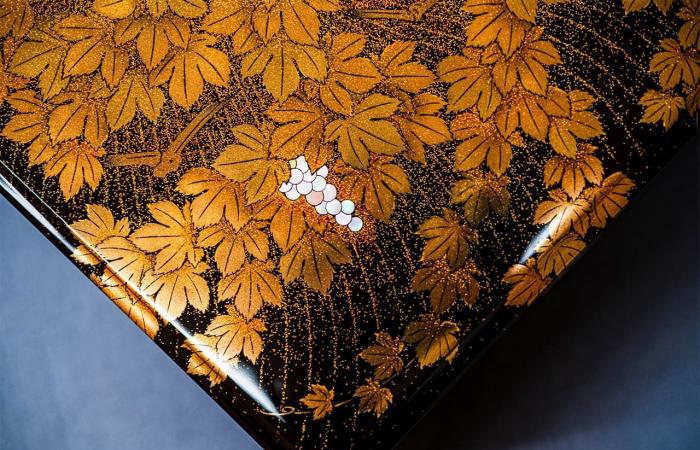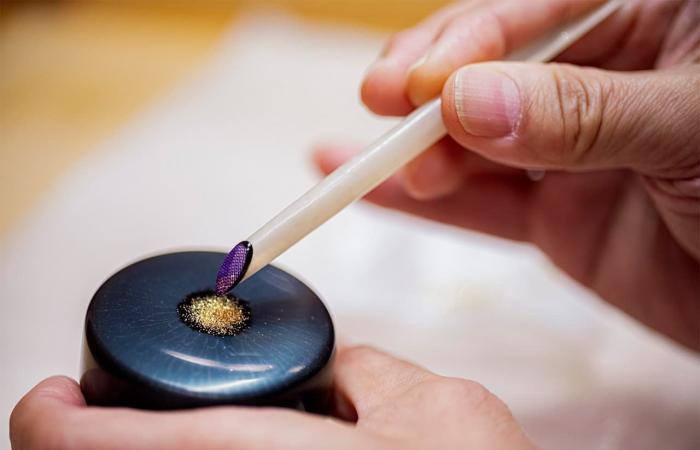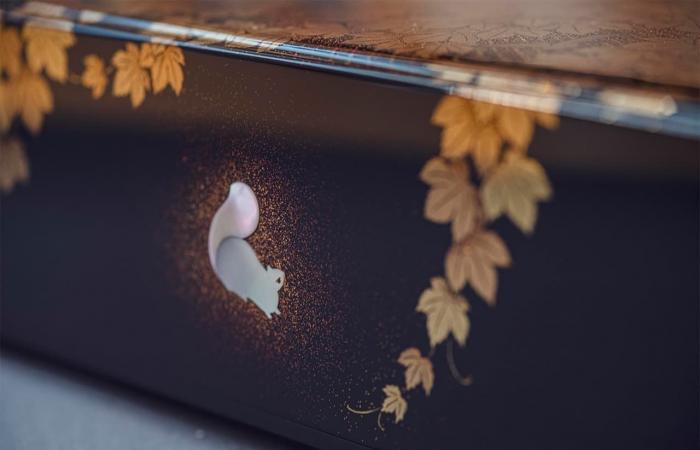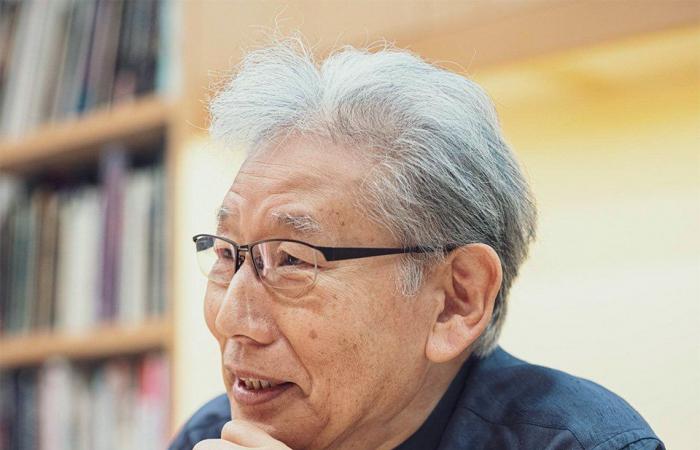
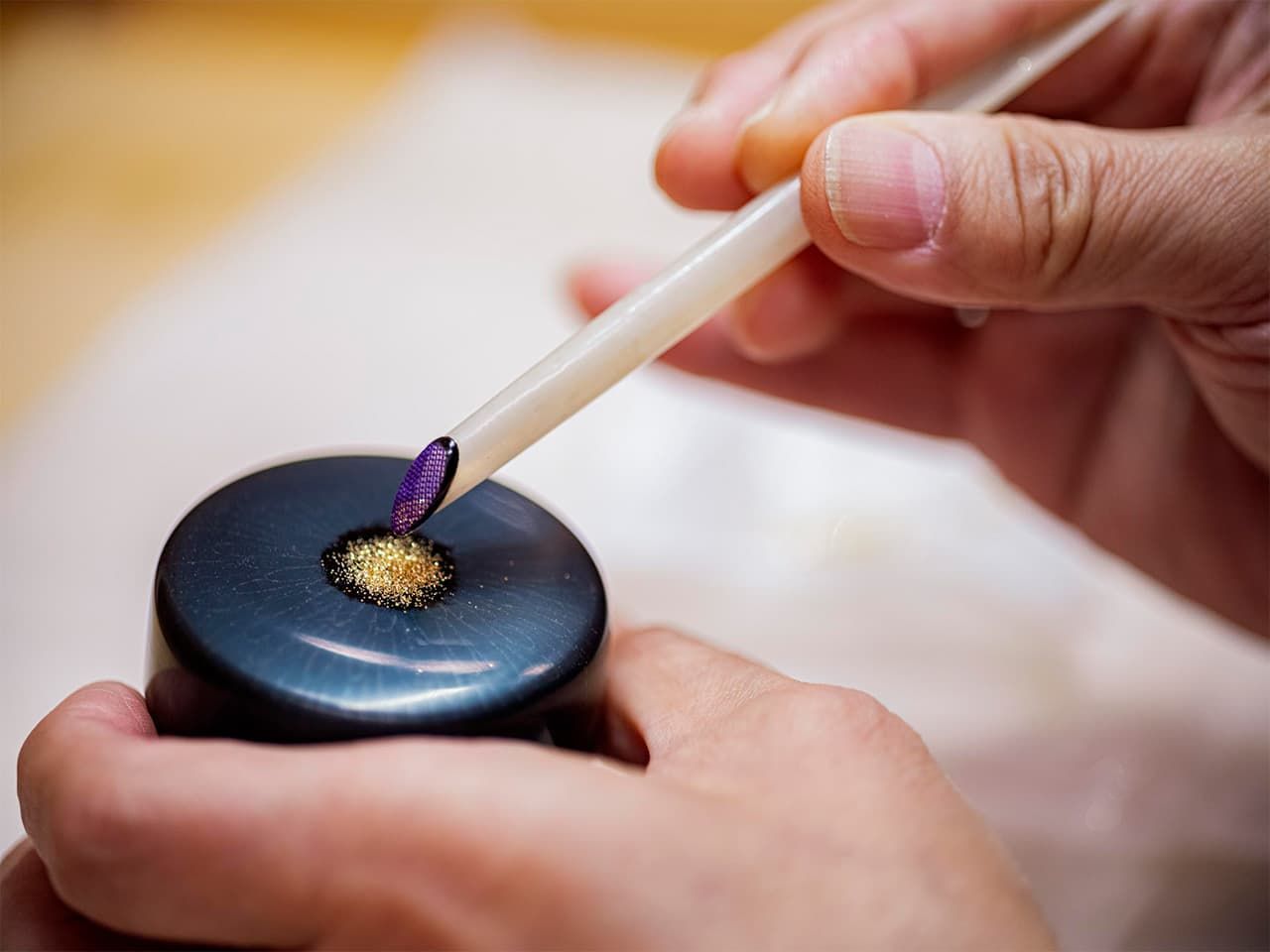




A creation that retains all its beauty even after 500 years
“Lacquer is like the decorative incarnation of light. This alliance of brilliant black and gold chandelier creates an outstanding brightness.
L’war-water is traditional refined Japanese lacquer, obtained from the sap of Toxicodendron vernicifluumbetter known as the Japanese lacquer tree. The application of this lacquer to wooden containers, whether it be soup bowls or works of art, to protect them and to decorate them, has long been an important element of Japanese lifestyle and culture.
Kazumi wall creates her works according to the technique of togidashi maki-e Where a pattern is first drawn on the object using metal paintings, and then covered with several layers of lacquer which are then brown with charcoal to let the drawing appear.

“Donation of heavens”, a box in mei-e To keep the letters, and encrusted with mother -of -pearl. Presented at the 70th annual exhibition of the Kôgei association in Japan. (With the kind authorization of the Kôgei association of Japan)
Completed in 2023, “donation of heaven” (Tenkei) is of great decorative richness, with its shiny lacquered surface like a mirror with colors, shapes, and various textures based on golden seeds which give a three -dimensional effect.
“I represented large clusters of grapes muzzling in the sun, with squirrels stripping around. I wanted to evoke the power of the sun which supports the growth of everything that is alive, and also the fullness of its grace. »»

(© Mori Masatoshi)
The creation of each work requires a time. considerable. First of all, the wooden base is reinforced by sticking a linen fabric on it. Then we apply a first layer of lacquer that we let dry before polishing it. This lacquer application process is repeated many times before moving to decoration.
For “donation of the heavens”, Murose drew the pattern of the leaves and sun rays with lacquer, then sprinkled with gold dust by tapping a bamboo tube called the finger called funzutsu. A new layer of lacquer is then affixed and, once very dry and hardened, the surface is polished with charcoal to bring out the pattern. As for squirrels and grape clusters, they are mother -of -pearl inlays made with a technique called Raden. Shells are cut and shaped, then applied to the lacquered surface which is then polished with charcoal.

The bamboo tube, called funzutsu (© Mori Masatoshi)
“An entire year can prepare the base and apply the many layers of liquid lacquer. Then comes the decoration work which, for a work such as “donation of the heavens” (making the size of an A4 and 10 cm high leaf), requires another year. If we count the time of design, the creation of a single work can easily Take three to four years. The lacquer becomes harder and more resistant with the years, and also more transparent. Preserved in good conditions, a creation keeps all its beauty, even after 500 years. When you work the lacquer, you acquire a very different concept of time. »»

Mother -of -pearl inlaid with technique Raden (© Mori Masatoshi)
The lessons of a father: the gesture rather than the words
His father, Shunji, was already a lacquer artist. His workshop occupied part of their house, and it was the young Kazumi’s playground.
“When I was seven or eight years old,” he said, “I wanted a plastic model of a motor boat. My father stuck several layers of cardboard on wooden slats to make the structure and then, instead of lacquer, he applied cashew nut oil. In the end, everything had the appearance of a Japanese ship rather than a motor boat. I played a lot with in the bath, and it was from this period that I was interested in crafts. When I think about it, it was his way of showing me by gesture rather than words how to create objects with his hands.
Murose Shunji often received illustrious lacquers, such as Rokkaku Daijô (who will become a co -lacken craft professor at the University of Tokyo Arts) and Masumura Mashiki (which is designated national treasure living in 1978 for the technique of lacquer kyûshitsu). The young Kazumi’s interest for lacquer is only growing and, at the age of 14, he asked to become his father’s apprentice. He then discovered for the first time the joy of creating a work.
“I grew up watching my father work and I always enjoyed creating. It was therefore obvious for me to become a lacquer craftsman. On the other hand, we could not live from it at the time. This is what my father was only repeating every time I told him about it. My teachers in high school also opposed it, telling me that all these old -fashioned traditions were going to disappear. And there, I told myself that in this case, I would like to be at their bedside until the end. »»
Once registered at the University of Tokyo Arts, Murose visited Matsuda Gonroku (national treasure living in the lacquer category, technique of technique mei-e Since 1955) who had been his father’s master, to tell him about his ambition.
“Even now, I have the memory of this meeting. I was so anxious. I was the age of his grandchildren, and he spent an entire afternoon talking to me about lacquer with such a passion. I then found in him the person I wanted to become. »»
That day, Matsuda Gonroku did not explain to him how to make works. He told her about the creative state of mind, what one might call the “philosophy of the creative process”.
“Matsuda said” you have to learn people, things, and nature “. The “people” he was talking about was those who preceded us and our masters. “Things” are the objects and techniques of the past. “Nature” is plants and animals, starting with lacquer war-wateras well as the vitality of nature. I always keep these words in mind when I try to express myself through my lacquer works. »»
It is from her father that Murose Kazumi learns the basics of lacquer production. He then perfected at Taguchi Yoshikuni (designated national treasure living in the lacquer category, technique of mei-e in 1989) who had been his higher cycle teacher, where he joined other techniques of mei-e.
“I don’t think it’s really possible to teach techniques. This is something that we end up acquiring by proceeding by trial and error. It is through the errors that we learn. »»
“Tradition is a succession of innovations”
Despite hard daily work, the life of a lacquer craftsman was not profitable.
“It was only when I reached the fifties that people started buying my achievements. In the meantime, you had to do something else to make a living. During the day, I restored works designated “important cultural goods”, and I teach. In the evening, I devoted myself to creation. This routine was my life for years, but I was at least happy to be able to do what I liked. »»
Murose has enormously learned from her work to restore cultural property. Reproduction of a box for cosmetic products, Umea national treasure of the Kamakura era (1185–1333), at the head of a team of 18 craftsmen and researchers, remains in memory.
“I had always thought that the golden background of mei-e was to be uniform in appearance, but by working on the box UmeI realized that in the mei-e From the Kamakura era, the granular aspect of gold dust was highlighted. I understood that the possibilities were endless and this is what allowed me to release my creativity. »»
The project took three years and ended in 1998. Murose was 48 years old and this is where it decides to cut its own golden shavings and create dust with particles of different shapes and textures to lead to three -dimensional creations.
The result of this emancipation was a work called Saiko (colorful lights), an octagonal box that combines the techniques of mei-e one you Raden. This play, created at the age of 50, was awarded the prize of the Governor of Tokyo to the annual exhibition of the Kôgei association of Japan in 2000.

“Colorful lights” (Saiko), an octagonal box that combines lacquer techniques mei-e and mother -of -pearl inlays Raden. Presented at 47e The annual exhibition of the Kôgei of Japan association in 2000. (With the kind authorization of the Kôgei association of Japan)
“For more than 1,200 years, tradition wanted the background color of a work of mei-e either monochromatic, black or golden. In “Colorful lights”, I anchored myself in this tradition while using mother -of -pearl and a technique called kanshitsu To enhance the colors, as well as a intake of gold dust from different consistency to try to deepen them. »»
“We tend to think that traditional crafts are simply a question of preserving processes and the aesthetic meaning of the past. But even if the basic techniques remain the same, the materials and the expression evolve. For me, tradition is a succession of innovations, and a work like this, which is a manifestation of a whole new expression, is of crucial importance. »»

(© Mori Masatoshi)
Murose is designated national treasure living in the lacquer category, subcategory mei-ein 2008. According to a press release from the Agency for Cultural Affairs, this designation is based on “the creation of works which are based on traditional techniques while instilling a very personal approach which brings a very varied palette of colors. His works are characterized by a sober structure representative of a modern sensitivity which is elegant and unique. »»
Art is a heart balm that enriches the whole world
Murose also works enormously in promoting the cultivation of lacquer. In 2007, he presented his works during an exhibition at the British Museum, and valued the culture of lacquer in London through a series of conferences and demonstrations. For more than 20 years, he has also been an advisor to the Victoria and Albert Museum, participating in studies on lacquer and teaching catering techniques.
In addition, the artist organizes workshops every year in Japan to introduce children to lacquer. This project began in 2012, after the great earthquake in eastern Japan.
“There are limits that one person can accomplish, but the activity of transmitting the beauty of the art and the craft of lacquer is the means of safeguarding culture, even when I will not be there anymore. »»

(© Mori Masatoshi)
Where does this passion that pushes walls to create and also permanently sharing comes from?
“Without my passion for lacquer, I don’t know where I would be today. This universe is extraordinary. Take lacquer objects in your hands, and feel wealth at the same time as lightness. Touching them soothes the heart. Art enriches the soul. I am convinced that if I send this message, even to one person, the world will be better. »»
(Interview and text by Sugihara Yuka and Power News.)


